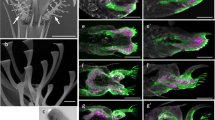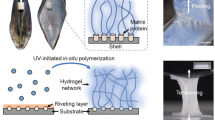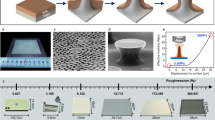Abstract
The adhesive strategy of the gecko relies on foot pads composed of specialized keratinous foot-hairs called setae, which are subdivided into terminal spatulae of approximately 200 nm (ref. 1). Contact between the gecko foot and an opposing surface generates adhesive forces that are sufficient to allow the gecko to cling onto vertical and even inverted surfaces. Although strong, the adhesion is temporary, permitting rapid detachment and reattachment of the gecko foot during locomotion. Researchers have attempted to capture these properties of gecko adhesive in synthetic mimics with nanoscale surface features reminiscent of setae2,3,4,5,6,7; however, maintenance of adhesive performance over many cycles has been elusive2,8, and gecko adhesion is greatly diminished upon full immersion in water9,10. Here we report a hybrid biologically inspired adhesive consisting of an array of nanofabricated polymer pillars coated with a thin layer of a synthetic polymer that mimics the wet adhesive proteins found in mussel holdfasts. Wet adhesion of the nanostructured polymer pillar arrays increased nearly 15-fold when coated with mussel-mimetic polymer. The system maintains its adhesive performance for over a thousand contact cycles in both dry and wet environments. This hybrid adhesive, which combines the salient design elements of both gecko and mussel adhesives, should be useful for reversible attachment to a variety of surfaces in any environment.
This is a preview of subscription content, access via your institution
Access options
Subscribe to this journal
Receive 51 print issues and online access
$199.00 per year
only $3.90 per issue
Buy this article
- Purchase on Springer Link
- Instant access to full article PDF
Prices may be subject to local taxes which are calculated during checkout




Similar content being viewed by others
References
Ruibal, R. & Ernst, V. The structure of the digital setae of lizards. J. Morphol. 117, 271–293 (1965)
Geim, A. K. et al. Microfabricated adhesive mimicking gecko foot-hair. Nature Mater. 2, 461–463 (2003)
Northen, M. T. & Turner, K. L. A batch fabricated biomimetic dry adhesive. Nanotechnology 16, 1159–1166 (2005)
Sitti, M. & Fearing, R. Synthetic gecko foot-hair micro/nano-structures as dry adhesives. J. Adhes. Sci. Technol. 17, 1055–1073 (2003)
Yurdumakan, B., Raravikar, N. R., Ajayan, P. M. & Dhinojwala, A. Synthetic gecko foot-hairs from multiwalled carbon nanotubes. Chem. Commun. 30, 3799–3801 (2005)
Peressadko, A. & Gorb, S. N. When less is more: Experimental evidence for tenacity enhancement by division of contact area. J. Adhesion 80, 1–5 (2004)
Crosby, A. J., Hageman, M. & Duncan, A. Controlling polymer adhesion with “Pancakes”. Langmuir 21, 11738–11743 (2005)
Northen, M. T. & Turner, K. L. Meso-scale adhesion testing of integrated micro- and nano-scale structures. Sensors Actuators A 130–131, 583–587 (2006)
Huber, G. et al. Evidence for capillary contributions to gecko adhesion from single spatula nanomechanical measurements. Proc. Natl Acad. Sci. USA 102, 16293–16296 (2005)
Sun, W., Neuzil, P., Kustandi, T. S., Oh, S. & Samper, V. D. The nature of the gecko lizard adhesive force. Biophys. J. 89, L14–L16 (2005)
Autumn, K. et al. Evidence for van der Waals adhesion in gecko setae. Proc. Natl Acad. Sci. USA 99, 12252–12256 (2002)
Autumn, K. et al. Adhesive force of a single gecko foot-hair. Nature 405, 681–685 (2000)
Huber, G., Gorb, S. N., Spolenak, R. & Arzt, E. Resolving the nanoscale adhesion of individual gecko spatulae by atomic force microscopy. Biol. Lett. 1, 2–4 (2005)
Arzt, E., Gorb, S. & Spolenak, R. From micro to nano contacts in biological attachment devices. Proc. Natl Acad. Sci. USA 100, 10603–10606 (2003)
Arzt, E. Biological and artificial attachment devices: Lessons for materials scientists from flies and geckos. Mater. Sci. Engin. C 26, 1245–1250 (2006)
Spolenak, R., Gorb, S. & Arzt, E. Adhesion design maps for bio-inspired attachment systems. Acta Biomater. 1, 5–13 (2005)
Waite, J. H. Nature's underwater adhesive specialist. Chemtech 17, 692–697 (1987)
Waite, J. H. Adhesion a la moule. Integr. Comp. Biol. 42, 1172–1180 (2002)
Waite, J. H. & Tanzer, M. L. Polyphenolic substance of Mytilus edulis: novel adhesive containing L-dopa and hydroxyproline. Science 212, 1038–1040 (1981)
Papov, V. V., Diamond, T. V., Biemann, K. & Waite, J. H. Hydroxyarginine-containing polyphenolic proteins in the adhesive plaques of the marine mussel Mytilus edulis. J. Biol. Chem. 270, 20183–20192 (1995)
Waite, J. H. & Qin, X. X. Polyphenolic phosphoprotein from the adhesive pads of the common mussel. Biochemistry 40, 2887–2893 (2001)
Yu, M. & Deming, T. J. Synthetic polypeptide mimics of marine adhesives. Macromolecules 31, 4739–4745 (1998)
Frank, B. P. & Belfort, G. Adhesion of Mytilus edulis foot protein 1 on silica: ionic effects on biofouling. Biotechnol. Prog. 18, 580–586 (2002)
Hwang, D. S., Yoo, H. J., Jun, J. H., Moon, W. K. & Cha, H. J. Expression of functional recombinant mussel adhesive protein Mgfp-5 in Escherichia coli. Appl. Environ. Microbiol. 70, 3352–3359 (2004)
Lee, B. et al. Rapid gel formation and adhesion in photocurable and biodegradable block copolymers with high DOPA content. Macromolecules 39, 1740–1748 (2006)
Lee, H., Scherer, N. F. & Messersmith, P. B. Single molecule mechanics of mussel adhesion. Proc. Natl Acad. Sci. USA 103, 12999–13003 (2006)
Whitesides, G. M. The origins and the future of microfluidics. Nature 442, 368–373 (2006)
Waite, J. H., Andersen, N. H., Jewhurst, S. & Sun, C. Mussel adhesion: finding the tricks worth mimicking. J. Adhesion 81, 1–21 (2005)
Dalsin, D. L., Hu, B.-H., Lee, B. P. & Messersmith, P. B. Mussel adhesive protein mimetic polymers for the preparation of nonfouling surfaces. J. Am. Chem. Soc. 125, 4253–4258 (2003)
Hutter, J. L. & Bechhoefer, J. Calibration of atomic-force microscope tips. Rev. Sci. Instrum. 64, 1868–1873 (1993)
Acknowledgements
We are grateful to the NIH and NASA for providing funding for this work. We thank J. Jureller and W. Russin for advice on optical imaging, B. Meyer for electron-beam lithography discussions, and V. Dravid and K. Shull for critical reading of the manuscript. Portions of this work used the NUANCE (EPIC, KECK-II and NIFTI) and biological imaging facilities at Northwestern University, the Nanobio facility at the University of Chicago, and the National Magnetic Resonance Facility at the University of Wisconsin-Madison.
Author Contributions P.B.M. planned the project, designed experiments, analysed data and wrote the manuscript. H.L. designed and performed experiments, analysed data and wrote the manuscript. B.P.L. designed and synthesized the polymer and wrote the manuscript.
Author information
Authors and Affiliations
Corresponding author
Ethics declarations
Competing interests
The corresponding author (P.B.M.) is a stockholder of Nerites Corporation, which supplied one of the polymers used in this study.
Supplementary information
Supplementary Information
This file contains Supplementary Figures 1-3 and Legends, Supplementary Methods; and Supplementary Video 1 Legend. (PDF 514 kb)
Supplementary Video 1
This file contains Supplementary Video 1. The Supplementary Video file contains six nanopillars of geckel contacting with a tipless AFM cantilever. (MOV 433 kb)
Rights and permissions
About this article
Cite this article
Lee, H., Lee, B. & Messersmith, P. A reversible wet/dry adhesive inspired by mussels and geckos. Nature 448, 338–341 (2007). https://doi.org/10.1038/nature05968
Received:
Accepted:
Issue Date:
DOI: https://doi.org/10.1038/nature05968
This article is cited by
-
Intelligent structured nanocomposite adhesive for bioelectronics and soft robots
Nano Research (2024)
-
Synthesis of robust underwater glues from common proteins via unfolding-aggregating strategy
Nature Communications (2023)
-
Synthesis of photoresponsive biobased adhesive polymers via the Passerini three-component reaction
Polymer Journal (2023)
-
Divergent Deborah number-dependent transition from homogeneity to heterogeneity
Nature Communications (2023)
-
Nature-inspired micropatterns
Nature Reviews Methods Primers (2023)
Comments
By submitting a comment you agree to abide by our Terms and Community Guidelines. If you find something abusive or that does not comply with our terms or guidelines please flag it as inappropriate.



